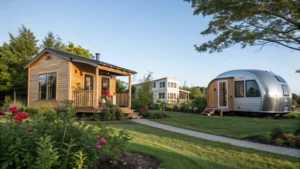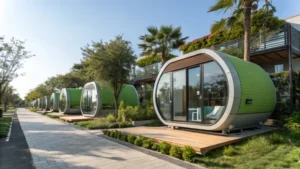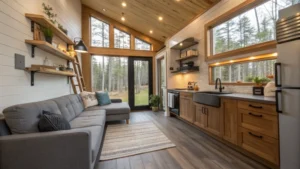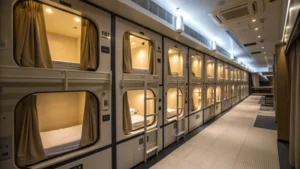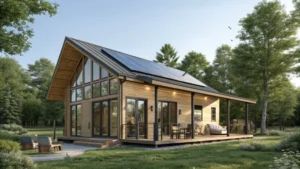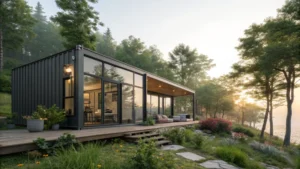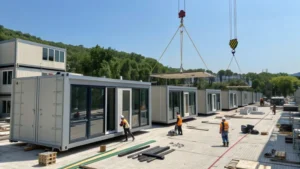
Ever wondered why those tiny capsule houses carry such hefty price tags? There's a fascinating story behind it.
Capsule houses are pricey because they use top-notch materials, cutting-edge production techniques, offer customization options, and must comply with strict regulations. These elements all significantly impact the cost.
I remember the first time I seriously looked into these compact homes, it was like opening a Pandora's box of innovation and cost factors. While the initial explanation highlights the main cost drivers, there's a whole world of details waiting to be explored. From the eco-friendly materials that ensure these homes last, to the high-tech manufacturing processes that promise precision, every aspect seems meticulously crafted. And let's not forget about the design options – the kind that makes your home truly yours – or the hoops we jump through to meet various international standards. It's this blend of art and science that justifies their premium prices. Let's dig into what makes these modern marvels worth every penny.
Capsule houses use high-quality materials.True
High-quality materials ensure durability and longevity, raising costs.
Capsule houses are cheaper due to mass production.False
Advanced manufacturing processes increase costs despite efficiency.
What Makes Capsule Houses So Pricey?
Ever wondered why capsule houses, these marvels of modern design, often come with a hefty price tag?
Capsule houses are expensive mainly due to the premium materials like high-strength steel and engineered wood that ensure durability and eco-friendliness, substantially raising construction costs.
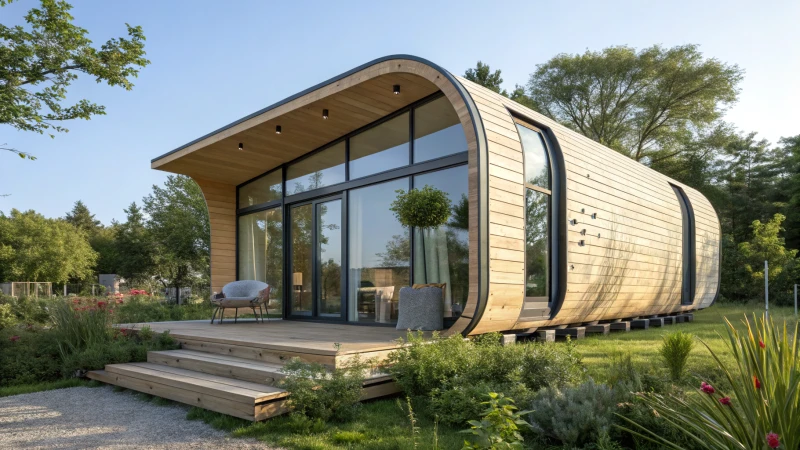
The Role of Premium Materials
When I first delved into the world of capsule houses, I was struck by the commitment to quality. The materials used—such as high-strength steel1 and engineered wood—aren't just buzzwords. These elements are chosen for their durability and sustainability, attributes that can dramatically impact the cost. Imagine walking into a space that feels like a fortress against time and nature—that's what these materials offer. But, of course, that peace of mind doesn't come cheap.
Advanced Manufacturing Techniques
I’ve seen firsthand how precision in manufacturing can elevate a product's quality. Techniques like CNC cutting and automated welding are not just about meeting specifications; they are about crafting something extraordinary. These processes require hefty investments in technology, but they ensure every piece fits perfectly, creating a seamless experience. It's like the difference between a bespoke suit and off-the-rack clothing.
Customization and Design Flexibility
One of the joys of working with capsule houses is the endless customization options. You can have bespoke layouts, luxury finishes, or even integrated smart technology. This level of personalization does come with a price, but it’s akin to owning a home that’s a true reflection of your personality. The flexibility in design means you can create spaces that not only look stunning but also function exactly how you need them to.
| Customization Options | Cost Increase |
|---|---|
| Bespoke Layouts | 20% - 50% |
| Luxury Finishes | 15% - 35% |
| Smart Technology | 10% - 25% |
Regulatory Compliance Costs
Navigating regulatory landscapes is never easy. Each region has its own set of standards that capsule houses must meet, involving extensive testing and certification. This compliance is crucial for safety and quality but also adds to the cost. It's like having insurance—you're paying for peace of mind knowing your home is up to code.
Shipping and Installation Expenses
The logistics of transporting and installing these homes can be a daunting task. I remember coordinating deliveries to remote locations—it's no small feat. Shipping costs can soar, especially when dealing with international transport, and installation requires skilled labor to ensure everything is set up correctly. These factors are significant in the overall pricing but are essential for a successful project rollout.
Understanding these aspects can truly help in appreciating the value of capsule houses. It’s not just about the upfront costs but also about investing in a sustainable and durable future.
Capsule houses use high-strength steel for structure.True
High-strength steel is used in capsule houses for structural integrity.
Luxury finishes in capsule houses increase costs by 50%.False
Luxury finishes increase costs by 15% to 35%, not 50%.
How Do Manufacturing Techniques Impact Costs?
Ever wondered how the choices you make in manufacturing can shape your budget and quality outcomes?
Manufacturing techniques influence costs by affecting material use, labor efficiency, and technology investments. While advanced processes like CNC cutting offer precision, they require significant initial costs that impact overall budgets.

Material Selection
I remember a time when I was deeply involved in a project that required choosing the right materials to balance cost and quality. High-quality materials like engineered wood2 and high-strength steel were on the table. Though they came with a hefty price tag, their durability promised long-term savings by cutting down on maintenance and replacements.
| Material Type | Cost Impact |
|---|---|
| Engineered Wood | High initial cost |
| High-Strength Steel | Increased longevity |
Choosing these materials wasn't just about upfront costs; it was about making a strategic investment in longevity and sustainability.
Technology and Automation
When I first learned about CNC (Computer Numerical Control) cutting, it was like discovering a secret weapon in manufacturing. This technology, along with automated welding, significantly enhanced precision and consistency in our products. However, I quickly realized that these benefits came with a significant investment3 in technology and skilled labor.
| Technique | Initial Cost | Long-term Benefit |
|---|---|---|
| CNC Cutting | High | Precision |
| Automated Welding | Moderate | Consistency |
Balancing these initial costs against their long-term benefits became a vital part of our strategy.
Customization and Design Flexibility
In the realm of bespoke designs, I've seen firsthand how offering luxury finishes4 or smart technologies can skyrocket costs by up to 50%. Yet, the appeal of customization cannot be understated. It demands extra design work and specialized materials, adding layers of complexity and cost, but also offering a unique edge in the market.
Customization not only enhances product appeal but also requires additional design work and specialized materials, adding to the overall expense.
Regulatory Compliance
Meeting international certifications like ISO or CE often felt like navigating a maze. The additional testing and quality assurance were time-consuming but crucial for ensuring safety and performance standards. Although compliance extended our timelines, it safeguarded our brand reputation and was an essential part of our cost management efforts.
Compliance is a non-negotiable aspect of manufacturing that safeguards brand reputation but requires careful cost management.
Logistics and Installation
Transporting products, especially to far-flung locations, was always a logistical puzzle. Effective planning kept shipping costs between 15–25% of the total project budget. Considering factors like distance, volume, and customs regulations5 was key to avoiding delays and extra costs.
Understanding these elements has been instrumental in optimizing our manufacturing processes to cut costs while upholding the quality standards we pride ourselves on.
High-quality materials reduce long-term costs.True
Durable materials lower maintenance and replacement expenses over time.
Automation always decreases initial manufacturing costs.False
Automation requires significant upfront investment in technology and labor.
Why Does Customization Drive Up Prices?
Customization can feel like a magic wand for making products truly yours, but have you ever wondered why it seems to stretch your budget too?
Customization drives up prices because it requires unique materials, complex design processes, and specialized manufacturing. These components demand more resources and skilled labor, increasing the overall costs.

The Cost of High-Quality Materials
I remember the first time I held a piece of high-strength steel intended for a custom project. It felt like holding the future in my hands—strong, reliable, and ready to stand the test of time. But such premium materials6 come with a hefty price tag, contributing to 30-40% of the total cost. It's a significant investment that ensures durability and meets client expectations, but it certainly influences pricing.
Advanced Manufacturing Techniques
Every time I walk into our advanced manufacturing facility, I'm awed by the precision of CNC cutting machines and automated welding equipment. These aren't just machines—they're artists that craft each detail with meticulous care. Of course, this level of craftsmanship requires substantial investments in both technology and skilled labor, driving up costs but ensuring quality that meets global standards.
Design and Development Expenses
I often find myself engrossed in meetings with our design team, watching them bring visions to life with bespoke layouts and luxury finishes. Their creativity knows no bounds, but such dedication means our base costs can increase by 20-50%. These design efforts require time and expertise, adding an irreplaceable uniqueness to each project.
Regulatory Compliance Challenges
Navigating the maze of international and local certifications feels like a game of chess sometimes—strategizing each move to ensure safety and quality compliance. This process can take weeks or even months, adding another layer of cost but ultimately ensuring that our products meet rigorous standards.
| Factor | Cost Contribution |
|---|---|
| Materials | 30-40% |
| Design | 20-50% |
| Logistics | 15-25% |
Logistics and Installation Considerations
Shipping our products to remote or international locations is like planning an intricate dance—every step has to be perfectly timed. Logistics can consume 15-25% of the project budget, adding another layer to the price structure as we strive for timely and effective delivery.
Niche Market Premiums
Our focus on niche markets like luxury eco-tourism allows us to cater to clients who value uniqueness. The growing market demand7 for these specialized solutions has been expanding by about 12% annually. It's a challenging yet rewarding space where customization truly shines.
High-quality materials account for 30-40% of customization costs.True
Customization often involves premium materials like high-strength steel.
Design efforts can increase base costs by 50%.True
Custom designs require more time and expertise, raising costs significantly.
How Do Regulations Affect Capsule House Pricing?
I’ve always been fascinated by how regulations shape our world, especially in the innovative realm of capsule houses. Understanding this can make all the difference for developers and buyers.
Regulations play a crucial role in determining capsule house pricing by adding costs for compliance with safety, environmental standards, and zoning laws. These can lead to expenses for testing, certification, and necessary design changes.

Regulatory Compliance Costs
Navigating the maze of regulatory compliance has been quite the journey for me. It's not just about ticking boxes; it's about ensuring that every capsule house stands the test of safety and sustainability. The international certifications like ISO and CE? They’re more than just acronyms; they're guarantees of quality that require extensive testing and assurance. I’ve seen how these processes can stretch timelines and budgets, yet they’re essential to delivering a product that can be trusted across borders. Certification costs8 can vary significantly depending on where you are, but they’re a non-negotiable part of the process.
| Region | Average Certification Cost |
|---|---|
| Europe | $5,000 - $10,000 |
| North America | $6,000 - $12,000 |
| Asia | $4,000 - $8,000 |
Impact of Local Zoning Laws
When I think about local zoning laws, it's like piecing together a puzzle where each region has its unique set of rules. These laws can dictate the very essence of where and how a capsule house can be constructed. There have been times when I've had to modify designs to comply with specific aesthetic or height restrictions—imagine the creativity required to maintain both compliance and design integrity! The adjustments sometimes involve additional consultations or legal advice, which inevitably impacts overall pricing9.
| Region | Additional Design Costs |
|---|---|
| Europe | $2,000 - $3,000 |
| North America | $1,500 - $2,500 |
| Asia | $1,800 - $2,200 |
Environmental Regulations
Incorporating eco-friendly materials into capsule houses isn’t just a trend; it's a commitment to a greener future. I’ve always believed that investing in sustainability is investing in longevity. However, these choices often come at a premium—one that reflects in the final pricing. Meeting green building standards10 involves meticulous planning and sometimes additional fees for audits and certifications, but it’s a step forward that I’m proud to take.
Building Safety Standards
Safety is paramount, and adhering to rigorous building standards ensures that each capsule house is not just livable but safe. I’ve learned that integrating advanced manufacturing techniques and using high-quality materials is key. It’s about reinforcing structures and sometimes incorporating state-of-the-art systems that boost costs but ultimately offer peace of mind.
The Role of International Standards
Staying competitive in the global market means embracing international standards that assure quality and reliability. It’s an investment in technology and processes that pays off by enabling me to deliver homes that meet worldwide expectations. Understanding these regulations is crucial for anyone involved in buying or producing capsule homes.
ISO certification increases capsule house costs.True
ISO certification involves testing and quality assurance, adding costs.
Local zoning laws rarely affect capsule house pricing.False
Zoning laws impact design requirements, affecting overall pricing.
Conclusion
Capsule houses are costly due to premium materials, advanced manufacturing techniques, customization options, regulatory compliance, and logistics, all contributing to their unique value and sustainability.
-
Exploring this link will reveal why high-strength steel is preferred in construction for its durability and cost-effectiveness. ↩
-
Discover why engineered wood is valued in construction for its durability and sustainability benefits. ↩
-
Learn how investing in CNC technology can yield long-term precision and efficiency gains. ↩
-
Explore how luxury finishes can enhance product value and affect pricing strategies. ↩
-
Understanding customs regulations is crucial for efficient international logistics management. ↩
-
Explore how high-quality materials impact pricing and why they're essential for customization. ↩
-
Understand how increasing demand allows suppliers to maintain high prices in niche markets. ↩
-
Discover the costs linked to obtaining ISO certification, vital for understanding compliance expenses. ↩
-
Explore how local zoning laws influence construction costs and housing market dynamics. ↩
-
Learn about green building standards and their impact on construction costs and sustainability. ↩



